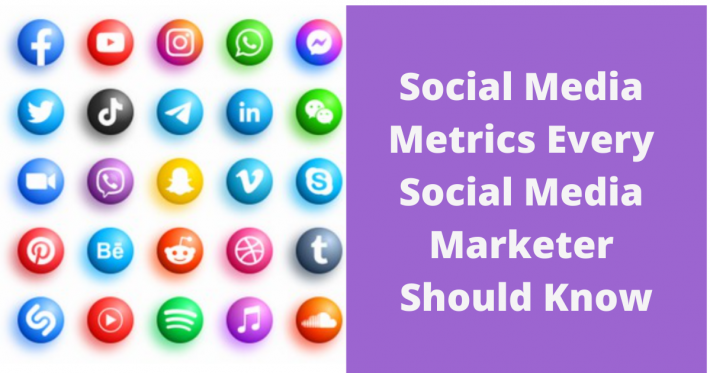Social media metrics are the use of information to measure the effect on a company’s income on social media activity. Marketers frequently use social media surveillance software to monitor social platform activity and collect data about how a subject related to a brand, product or company is perceived.


Why Should You Track Social Media Metrics

Social Media Metrics are an integral part of any marketing strategy seeking to grow its online presence. Through tracking the efficiency of social media posts you can make better strategies and increase the reach and audiences.
Social Media Metrics That Matter
Engagement
The perfect engagement metric operates on a scoring scheme and involves requirements such as reaching the crowd, sharing and commenting to give a full image of how the message was received and what the reaction was. Understanding how many engagements your supporters perform on average is far more important than knowing how many supporters or likes you have individually.
Engagement with social media demonstrates how many individuals communicate with your content. A high engagement rate shows a good connection between your company and your audience. Engagement metrics to be analyzed are:
- Average Engagement: Number of likes, shares, comments over a given period of time (e.g. week, month).
- Amplification Rate: Ratio of shares per post to the number of overall followers.
- Virality rate: Total number of shares divided by the total number of views/reach multiplied by 100.
You can monitor engagement on Facebook, Instagram, Twitter, Pinterest — any platform where individuals can like your posts or comment on them.
Click-Through Rate

Click-through rate is the measurement of the number of clicks advertisers receive a per number of impressions on their advertisements. It’s essential because it demonstrates how often links are clicked on in your social media posts.
Your PPC achievement requires an elevated click-through rate because it directly impacts both your quality score and how much you pay when someone clicks on your search ad. Click-Through Rate works well for measuring both organic and paid posts.


Click-Through Rate= Total Clicks on Ad / Total Impressions
Naturally, click-through rates will differ from campaign to campaign, and from keyword to keyword. It all plays a part in the way your ad is displayed, from your ad copy to the results page ranking of the ad.
The average click-through rate will differ by sector and, among other variables, your anticipated CTR will depend on the place of your ad.
Achievement of a higher Click-Through Rate depends on:
- Targeted bid Keywords
- Cost-efficient clicks
- The close integration of keywords with ad text and landing pages tools and methodology.
- The ability to segment keyword groups quickly and efficiently to generate closer targeting.
Click-through rate helps you make comprehensive decisions about upcoming content and helps you enhance your click-through rate further. This is an important metric that you can use to optimize the quality of your content and therefore the results.
Click-Through Volume
Measuring clicks provide a quick way for our followers to understand what they want more. This helps to work on the content that can enhance the engagement and leads.
Landing Page Views
A landing page view is when a visitor lands on your ad’s destination URL (landing page) after clicking a link embedded in your advertisement.
An ad or post can receive clicks throughout the day, but that doesn’t imply anything unless those customers reach your website. Landing page views is a way to measure the traffic that actually wants to go to your website.
Optimizing landing pages is a way to enhance the traffic quality received by your website because of your advertisements. Visitors may not be able to view your landing page if your landing page is slow to load.
Referral Traffic
Referral traffic defines the individuals who come from other websites to your domain without using Google to search for you. When someone visits a link from a social network or website and ends up on a different page, Google’s tracking systems acknowledge the visitor as a reference.
Every time you share a piece of material on social media, you have the chance to build up relationships with your followers, enhance your SEO and generate a chance to send referral traffic to your website.
Businesses need to communicate with their audience and create relationships on each of their networks to take complete advantage of referral traffic through social media.
There are many ways that businesses can use social media strategies to boost their referral traffic. For example:
- Share posts at times when your followers are most active.
- Maintain consistency by using a scheduling calendar.
- Use your website’s social media plugins to facilitate social sharing.
- Make your content as visual as possible by using images in your posts.
Demographics

Each platform’s social media demographics is an essential step to be taken before determining which platforms are most useful to your brand. Invest your precious time to promote the correct content types for each appropriate platform.
For each platform your audience uses, adapting your content strategy is an excellent way to engage them. And step one is knowing who in those platforms includes the crowd.
You should check what posts are viewed by companies, titles, and geographies. This will give you insight into your messaging and feedback.
Conversions
Conversion rate is the number of visitors who take action on a page against the total visitors of that page after clicking on a link in your post.
The KPI measures the effectiveness of social media campaigns in generating website traffic and conversions of goals. Social media marketing needs to feed into other areas of your marketing and sales efforts and provide a measurable return on investment in marketing.
One of the most reliable ways to measure ROI on social media is to monitor the amount of web traffic coming from each social platform and how many goals these visits result from.


It is possible to analyze social media traffic to determine which sites are most valuable for your social media efforts. You can understand how well your message resonates with that audience by calculating target conversion rates (GCR) for each social media site. If the message is timely and relevant, this will reflect your target conversion rates; if target conversion rates are low, you may need to re-evaluate your strategy to cultivate leads of higher quality.
The conversion rate is incredibly important to track. If you are driving a lot of traffic to your website via social media campaigns — but your traffic is not converting — you should re-think your strategy and user experience.
Leads
Lead generation is a marketing process to stimulate and capture product or service interest for the development of a sales pipeline. Lead generation often uses digital channels, and the rise of new online and social techniques has undergone substantial changes in recent years.
Social media is not only a very important channel for engaging or connecting with your target audiences, but it has also evolved into a new digital marketing culture that has a strong influence on the buying behavior of consumers.
Content is a great guide to a landing page for users. You generate content typically to provide useful, free information to visitors. Social media platforms make it easy for your followers to take action, from swipe-up to Facebook bio links on Instagram stories to bitly URLs on Twitter. On your social posts, you can also promote your offers and include a call-to-action in your submission.
You need to know how many leads you generate from each channel of social media. Google Analytics should be used by marketers to track how many leads they receive from each social platform. Also, you should know which platforms generate real sales.
You can link social media posts to landing pages and measure indirect lead-gen value by seeing the pages on which your social references originally landed before they eventually converted.
Start creating unique and engaging content for your social supporters and make an impact that drives sales and pumps people around your brand.
Interactions

All marketers are expected to track interactions such as comments, shares, and retweets. These are the best forms of engagement, and they enable a two-way street conversation between consumers and a business that ultimately helps drive more sales.
Metrics of interaction to be tracked are:
- Comments: Having views and lots of comments and likes are important. The number of focused comments you receive is much more important to track. A focused comment is a comment on one of your posts that has to do with what the post is about. There are many comments posted on influencers post, but the ones that are the most relevant should be tracked. Knowing the number of focused comments that influencer content receives is much more useful to the sponsor.
- Shares: Shares are always a key measure of how well you connect with your crowd. Share means this audience member didn’t just like the material, but they enjoyed it enough to share it with their supporters. Shares provide third-party validation to companies that have been demonstrated to result in enhanced conversions and revenues. Sharing content is much greater because it helps to distribute messages organically across private networks.
- Upvotes: Upvote is a technique on the Reddit site that allows users to signal a post’s approval or support. Upvotes move a post to the top of the page and are a way of measuring how many individuals support the content in a post. It implies that your post will be noticeable for longer and drive more traffic for each upvote your post receives. So tracking upvotes is an excellent metric.


Impressions/Views
Impressions are when on a user’s computer an advertisement or any other type of digital media renders. Impressions are not action-based and are defined merely by a user who may see the advertisement.
Impressions seldom correlate with leads or a direct boost in site traffic, but they are still the most basic information you can collect. Without knowing how many individuals your article has seen, it is difficult to cross-refer to those other metrics, such as shares or leads, to understand what is gaining traction and what is falling behind.
Measuring impressions is fundamental for any practical analysis. Impressions is a base point without which you won’t be able to calculate/measure your other results.
Before engagement comes awareness, reaching out and impressions drive people to act. Without the other, you can’t have one, and without tweaking the others you can’t improve one. So when you’re considering how to increase engagement, do so while also considering how reach and impressions are playing into it.
Follower Growth Rate
The Followers Growth Rate measures the number of new followers you have gained over a given time on a specific social media platform and compares this to a predetermined goal. It is not only essential to assess how many fresh followers you get, but also to compare it with your goals or even your rivals. This offers an indication of your “conversation sharing” on a specific platform and your achievement.
While a large rate of followers may make your execs on social media feel great in the short run, this is not a real measure of achievement. Instead, when it comes to working out your performance, how many followers you acquire over a given time is much more useful.
You simply take the number of new followers you have gained over a period of time and divide them by the number of followers you had at the beginning of that period.
Strategies to increase your social media followers are:
- Identify your objectives and goals. Make sure that you understand how each platform operates, what audiences you can achieve and what your goals are.
- Interact very often with your accounts — react to your audience’s messages and communicate when interest is shown.
- Make sure that all your website pages contain your social media icons.
- Share different and unique content on every social media platform. Create different content for each platform.
- Contests on social media and sweepstakes can be extremely efficient instruments to grow your social media following.
Social Media Metrics – Conclusion
With so many metrics in social media marketing, selecting the ones that will most assist you can be hard.
Tracking the social media metrics that matter is how to transform fundamental reporting into something essential to effectively drive your approach forward as you gain a stronger understanding of how your present attempts pay off and where you can enhance to increase your ROI.


Nice article you have made here, It’s an informative and interesting post, keep it up.
It is truly a nice & useful piece of info. I am glad that you just
shared this useful information with us
Thanks a lot for your nice post and also thanks for giving your time for the post. Great help for me!